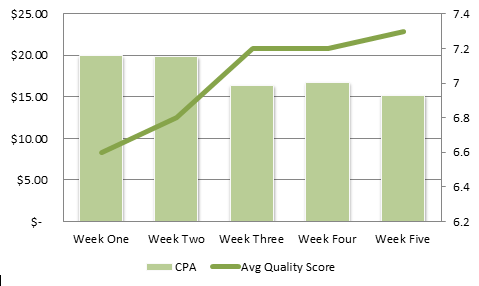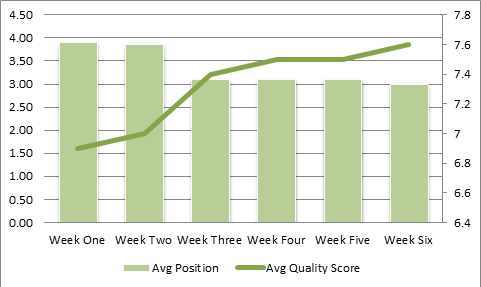When building out and launching a new PPC campaign, approaching match types and your bidding strategy correctly is extremely important in getting your new account off on the right foot.
When set up properly, a combination of all match types can help you cover the ground needed to drive high quality, relevant traffic to your site. But in order to get optimal performance, you need to make sure a tiered bidding strategy is utilized.
Match Types & Your Tiered Bidding Strategy
Let’s start by looking at what we want each match type to cover and how it plays an essential role in our marketing efforts.
Exact Match
This match type lets SEM managers target specific queries and target the searcher with specific ad text. When a granular account structure is utilized, ad text can match up directly with what a user is searching for. When the search query matches up with ad text and landing page, this presents an opportunity to achieve a high quality score.
In a tiered bidding strategy approach, exact match should be by far the most utilized match type.
Phrase Match
This match type can play a supporting role to the keywords that you haven’t covered in exact match. When used correctly, phrase match enables you to target long-tail queries, while still showing relevant ads.
When attempting to set up a tiered bidding strategy approach is it important to include your “route” keyword phrases as phrase match keywords. For example, if you sell shoes online, it would benefit you to have the following keywords on phrase match.
- Black Nike Shoes
- Red Nikes Shoes
- New Nike Shoes
Since you most likely don’t have the search query “size 14 black Nike shoes” as an exact match keyword, this enables you to still show a relevant ad to the search query. Again, relevant ads and relevant landing pages equal better quality scores and lower CPCs.
Broad and Broad Match Modified
Google’s moneymaker and an SEM manager’s worst enemy, this match type should be used sparingly but still can help catch unique, long-tail search queries. More than 25 percent of Google searches are the first time a specific query has ever been searched for, so attempting to cover every search query with exact match is impossible.
Broad match can work as a bucket that catches all of the long-tail search queries that don’t match up with your exact or phrase match keywords.
For example, while phrase caught the search query “size 14 black Nike shoes”, you’ll need your broad or broad match modified keyword to catch “size fourteen black and red lebrons”. This search query is quite far down the purchase cycle as someone is searching for a specific size and shoe. This may be their eighth search, but it is most likely the click that will lead to a conversion.
Tiered Bidding
In order to implement the tiered bidding part of this strategy, you will need to decrease your bid based on match types.
For example:
- Exact Match: $10
- Phrase Match: $8
- BMM: $7
In theory, your exact match keyword most likely has the highest quality score if your account structure is set up properly. With tightly themed campaigns and ad groups as well as extremely relevant ads and landing pages, this should be the case.
Phrase should follow suite based on the same theory, but you may run into a slight decrease in quality score due to a lack of relevancy for certain queries or a decrease in click-through rate (CTR) due to showing up for non-relevant queries.
According to Google, quality score is calculated for every specific search, so you will need to monitor match types and queries. Once you have enough historical data built up, fluctuation of quality score should slow down quite a bit.
This bidding approach allows for you to consistently have your exact match type keywords be shown for searches. Phrase and broad support exact match by catching terms that you may not have thought of or added as an exact match keyword yet. Broad match modified or broach match helps catch all of the new queries that searchers look for that weren’t included in your original build.
Run Search Query Reports
For this strategy to succeed, you must continue to add new search queries that are caught by phrase and broad match keywords. Run search query reports on a weekly or biweekly basis and make sure you frequently add the new search queries that come up more often as exact match keywords.
Results
Putting this strategy into action isn’t easy. For many accounts, restructuring to a more granular approach will be needed.
In order to invest the time to restructure, it must provide a positive ROI. Here are some of the results seen after implementation.
Decrease in Cost Per Acquisition
Over a five-week period after this strategy was implemented for a site in the insurance space, there was a 24 percent decrease in cost-per-acquisition.
Since many of the search queries that were originally getting matched to broad or phrase match keywords weren’t being matched to exact match keywords with higher quality scores, this decreased CPCs. As more exact match keywords were added and broad keywords paused, naturally there was an increase in quality scores across the account.

Note the largest jump in quality score and decrease in CPA occurred during week three after the new keywords were able to build out performance history.
Increase in Average Position
After seeing such positive results with the previous implementation of this strategy, a roll out to additional accounts began.
One specific account experienced similar improvements in quality score and its average position naturally increased. The account was able to increase the overall traffic the client’s website by 18 percent without increasing bids over a six-week period.
As you can imagine, the increase in quality score led to an increase in ad rank, which means higher positions and more traffic.

Summary
While this approach doesn’t guarantee great results, the above pattern takes shape more often than not. Sure, ongoing bid optimization needs to be made, but the tiered strategy can help you drive search queries to the optimal match type and view the correct ad.

